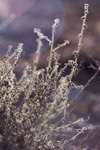

Developing flowers on the wormwood shrub. At this stage, the plant is collected for medicinal use.
WORMWOOD IS ENIGMATIC; WE cannot with certainty name the plant indicated by the Hebrew la’anah in seven Bible verses. But since la’anah is linked with gall in two instances, a different plant than wormwood could be intended. As implied in the verses, the plant should be bitter, be used for making a decoction (prepared by boiling the plant extract), and be drunk without poisoning (Jeremiah 9:15, 23:15).
In the New Testament, wormwood is found only in Revelation 8:11, where a star is called Wormwood. The Greek word is apsinthos, which implies a bitter or poisonous plant. This verse states that some who drank of the wormwood died, suggesting that it is toxic. Of course, we must take into account the symbolic imagery of Revelation before assigning a botanical name to the wormwood.
What native plant in the Middle East conforms to the characteristics of wormwood in the Bible? Most studies on Bible plants (for example, Harrison 1966) implicate a compact, woody shrub in the sunflower family, Artemisia herba-alba, known in English as wormwood. Wormwood has been known as a medicine since ancient times. A decoction of the leaves is used to cure intestinal worms, hence the common name. But today the plant is seldom used for its antihelminthic property.
Heavily grazed wormwood shrub in July, near Wadi Mousa, southern Jordan.
A flavoring for alcoholic drinks is made from wormwood, which is known in English as absinthe, directly derived from the Greek word used in the New Testament. It is also known as “bitters.” Absinthe has an intensely bitter taste, which may add to its desirability as a medicine under the philosophy that anything that tastes that bad must be good for you.
Wormwood is the dominant plant in vast areas of steppe in the Middle East. The silvery green leaves of this shrub give it a distinctive appearance when the rest of the vegetation is dry. Unlike many members of the native flora, the wormwood plant flowers in the middle of the summer. In addition to its medicinal value, it is a valuable fodder plant, and in some areas wormwood is severely overgrazed.

Threshing floor for lentils east of Bethlehem. The same threshing floor is used for barley, which is harvested at about the same time.